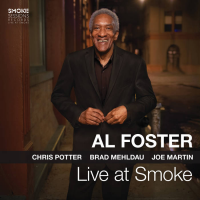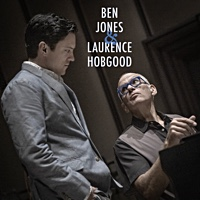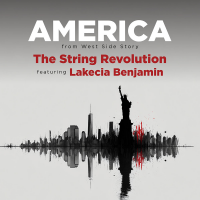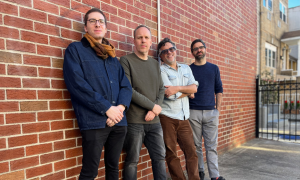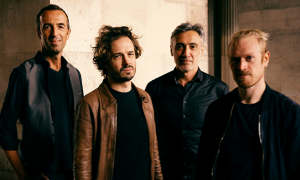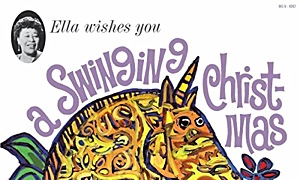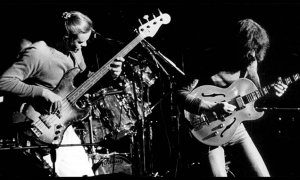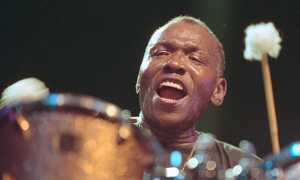Home » Jazz Articles » Inside the Songs » Tropos: Outer Space Chamber Music
Tropos: Outer Space Chamber Music

Courtesy Tarishi Gupta
We employ various degrees of freedom and strategies to really blur the line between improvised/composed, unplanned/planned, however you want to think about it.
—Yuma Uesaka
Throughout the album, music expands and collapses like deflated pool toys. At times, it feels like going through the long-term effects of a pharmaceutical roller-coaster ride. But then you hear something played by pianist Phillip Golub, his fingers caressing the keys like Alicia de Larrocha conjuring a Bach partita, while the ride coasts on a straightaway. But soon the uphill climb begins with the sound of the chains pulling your car emanating from Ledah Finck plucking the strings of her violin. Aaron Edgcomb's percussive strokes portend the top of the hill and the swift descent to follow when Yuma Uesaka's clarinet signifies the drop and rise and drop again. It is a thrill ride, listeners.
The ensemble's members write their own music and also focus on group improvisation and interaction. The term they use is outer space chamber music, which describes their style, pushing the boundaries between new music, jazz, and noise. Perhaps they can be seen as part of the troposphere, the lowest region of the atmosphere. "Tropos means "turn" in Greek," Uesaka wrote by email, saying: "Interestingly enough Steve Coleman put out a double album titled Polytropos/Of Many Turns (Pi Recordings, 2024), maybe there's something in the air... (or up in the troposphere)."
This is the ensemble's second full album following Axioms // 75 AB (Biophilia Records, 2020), which had an entirely different cast of players with the exception of Gollub. It was much of the same stark, compelling original music set alongside probing versions of classic Anthony Braxton compositions from the 1970s. That starkness is evident on the title track "Switches," but they felt that sentiment also applies to the whole album. "It is where we traverse through intensity/serenity, serious/playful, etc.," Uesaka said. "It's a very dynamic album and we felt that word was apt."
Uesaka continued when asked how much structure and where it may be found in the pieces on the album. "The amount of structure varies from piece to piece, but each piece deals with macro structures (as in, the form and the larger flow is mostly set). That said, within each section of each piece, we employ various degrees of freedom and strategies to really blur the line between improvised/composed, unplanned/planned, however you want to think about it."
How is the direction and flow determined? "Again, this depends on which piece we are talking about," Uesaka explained. "But in general, the composition often has some sort of a strategy (however opaque it may be to the listener) that gives the members of the band a clue to when we might be shifting musically or energetically. For example, in 'Lukan,' there's a bass clarinet solo in the middle and the transition into the next section is led by the violinist and the pianist who cue a melodic figure that is the signal for us to move on. We'd have to go into the specifics if you're curious about particular compositions, but for the most part there is a method to the madness."
Method. Madness. It is up to the listener to figure that out, should they be so inclined. For some, Switches may be like chomping down on a piece of Nicorette gum and feeling your capillaries surge and tingle. Shock and awe. It is showtime! For others, the album can be contemplative and perhaps you would try to focus as a squirrel intent on collecting acorns.
Well, enough said. It is time to let the four members of Tropos impart some ideas as to what's going on "Inside the Songs" on Switches.
Witchess
Yuma Uesaka: While "Witchess" is the first track of the album, it's the last piece that was developed right before the recording session. It was in reaction to "Switches" (the track) and originally conceived to be a piece that is played right after "Switches." but it can stand on its own. The initial idea behind this piece is the opposite of "Switches"—low musical contrast, repetitive almost to the point of boredom, but (hopefully) with enough peculiar sounds that set the tone for the absurdity this album deals with. This track also features a wild solo by our violinist Ledah Finck against the backdrop of the relentless repetitive figures. Finally, for the future PhD students out there if music academia still exists in 80 years and assuming people care about what I've written: 1) at the end of the piece, I quote my own composition Post (released with Ocelot under 577 Records), which also deals with repetition, 2) the transitional passage out of the piano solo is a reference to "Lukán," which appears later in the album, and 3) in hindsight, this piece is sort of like Louis Andriessen (Worker's Union) meets Helmut Lachenmann (Dal Niente) meets Anthony BraxtonThe Best Donuts in Pennsylvania
Ledah Finck: Playing in Tropos has really expanded my notion of composition. Before I joined the group, I was writing mostly fully-notated concert music, or not-at-all-notated songs. This piece was something new for me: a mostly single-line score full of different pathways the performers can take. I constructed it with the playful virtuosity of my bandmates in mind, and they certainly brought that energy to our interpretation of it. Developing it together allowed for a number of experiments with meter that pushed us into a certain wildness that I love about playing this piece together.Mother in Lieu
Phillip Gollub: "Mother in Lieu" makes our ensemble sound like a chattering of voices. The lines we play together have an irregular speech-like quality. Over the course of the piece, different types and registers of conversation are explored. Sometimes there's agreement, sometimes disagreement, sometimes everyone's talking over each other, and sometimes everyone's focused on one point. A sprinkling of Baroque ornaments encourages a certain serious-silliness in the playing, which Ledah, Yuma, and Aaron especially embrace in a more open section at the climax of the tune. Our quartet's instrumentation is unique and interesting for several reasons. Perhaps most strikingly is the lack of bass. Instead of trying to make up for the lack of bass by writing left hand piano or bass clarinet figures, most of the pitches you hear in this song are in the range of the human voice—the middle registers—again emphasizing the speech-like quality, except for a few select moments where the bottom falls out.Lukán
LF: The seed of this music was that I had a dream in which someone said to me "lukán' is a really beautiful word, you should use it for a band or song name." It doesn't seem to actually mean anything relevant in any language as far as I can discover, but I woke up with the sensation of rippling water on my mind, and this was the music I wrote to try to capture that. Yuma's bass clarinet solo is one of my personal favorite moments of Switches.Switches
YU: One of the meanings behind this track is a commentary on the album itself. Through the years spent collaborating as a group to workshop/develop these compositions, we develop a natural contrast between all the tracks because they're all written by different bandmembers. It's also fun to note that this piece came out of a conversation I had with Phillip (our pianist) about a Morton Feldman quote "Contrast is for people who can't write music." (Side note: upon further research, it was likely La Monte Young who said this). So, I thought it'd be an interesting compositional challenge to maximize contrast amongst various parameters (volume, density, orchestration, timbre) while giving a lot of space for individual autonomy (there's minimal traditionally written materials here but the types of sounds/gestures are very specific).Between the Times
PG: This piece is almost the polar opposite of "Mother in Lieu" and "Headline." It's an austere ballad which employs the full range of the ensemble from the lowest notes on the bass clarinet to the highest harmonics on the violin. One eerie five-note melody repeats, develops, and passes around the ensemble. I feel there is a very secular quality to this piece: it's about "things"—feelings you have while going about your life, on the subway, at the dinner table, and so on.Aerator Debris
Aaron Edgcomb: I've long been intrigued by the idea of rhythmic structure as form. Imagine if a standard were not a harmonic and melodic-driven form, but instead 32 bars or 128 beats for you to do whatever you want over. "Aerator Debris" is a four-measure structure (three measures of 4/4 and one of 7/8) with some debris scattered over it. The players can play the debris, or just play in or at or around the rhythmic structure. Then there is a contrasting B section, and a coda. I really love what Yuma and Ledah did with the coda in the session—took it and ran with it exploring some incredible harmonic ideas. A highlight is Yuma's slap-tongue bass clarinet solo.husk
AE: I have a series of pieces named after Melpomene, the Greek muse of tragedy. Sometimes you just need to write a song when you're depressed, and usually when I do that it gets added to the list of Melpomenes (I'm up to eight now). "husk" could just as well fit under that category, but when I wrote it I couldn't stop thinking about the image of an emotional husk, a dried out crackling shell filled with void of self. So, husk. The bulk of the tune is just six measures long, with two contrasting melodies, a romantic lyrical one, and a rhythmically and sonically atonal one. These melodies are at first contrasted, as exterior and interior, followed by a gorgeously demanding solo from Ledah. I have in the past played the piece as just those six bars, but for Tropos we decided to extend it. After Ledah's solo we release into a minimal open improvisation, one that is simultaneously empty while being filled with anhedonic ab/pre/sence. This kind of space is something I come back to in my music; it kind of feels like holding your breath underwater and looking around. Phillip then brings in a third melodic structure, a bit of a surfacing. Phillip's solo over this is energizing but in an uplifting way. Finally, we return to the head material and hear the coalescing of our original themes.Headline
PG: "Headline" is somewhat of a sibling piece to "Mother in Lieu." This piece was written to try to cause a heightened state of awareness amongst the performers. There are a couple of moments where we are all improvising at once and must very quickly catch a melodic cue together. I gave the instruction in rehearsal once regarding these cues: "If it could be the time we're moving on, it is the time we're moving on." There are also two moments where there's a "solo break," but it isn't defined who is supposed to take the break. This creates a sense of anticipation and perhaps even a bit of healthy anxiety in us, which I think comes across in our performance.Tags
About TROPOS
Instrument: Band / ensemble / orchestra
PREVIOUS / NEXT
Support All About Jazz
 All About Jazz has been a pillar of jazz since 1995, championing it as an art form and, more importantly, supporting the musicians who make it. Our enduring commitment has made "AAJ" one of the most culturally important websites of its kind, read by hundreds of thousands of fans, musicians and industry figures every month.
All About Jazz has been a pillar of jazz since 1995, championing it as an art form and, more importantly, supporting the musicians who make it. Our enduring commitment has made "AAJ" one of the most culturally important websites of its kind, read by hundreds of thousands of fans, musicians and industry figures every month.






